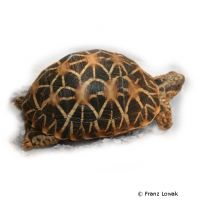Indian Star Tortoise (Geochelone elegans)
| Indian Star Tortoise Geochelone elegans | |
|---|---|
| Name | Indian Star Tortoise |
| Name Lat. | Geochelone elegans |
| Family | Tortoises |
| Family lat. | Testudinidae |
| Order | Turtles |
| Order lat. | Testudines |
| Origin | South Asia |
| Habitat | Dry savanna |
| Diet | Herbs, grass, veggies |
| Humidity | 60-70 % |
| Behavior | Peaceful |
| Keeping | Individual, pair, harem |
| Care Level | Difficult |
| Reproduction | Oviparous |
| Housing | Semi-humid terrarium |
| Life Span | 50 years |
| Protection | CITES Appendix I; EU Annex A |
| Metric Units | |
| Size | 35 cm |
| Temperature | 25-28 °C |
| Temperature Local | 35-45 °C |
| Housing Size | 300 x 150 x 100 cm |
| US Units | |
| Size | 14" |
| Temperature | 77-82 °F |
| Temperature Local | 95-113 °F |
| Housing Size | 120" x 60" x 40" |
Distribution and habitat
The distribution area of the Indian Star Tortoises is India, Pakistan and Sri Lanka. There they live in flat, dry grasslands as well as in moist, hilly forest areas. In Sri Lanka they also live in sand dunes and overgrown cultivated land.
Maintenance
Minimum dimensions for the terrarium, according to the size and number of animals:
| floor space for 1-2 animals | 8PL x 4PL (L x W) |
The carapace length (PL) is measured on the largest animal. For each additional animal the base area has to be increased by10 %, from the 5th animal on by 20 %. A terrarium of e.g.300 x 150 x 100 cm is recommended, which should be placed in a quiet and vibration-free place
They need a terrarium structured with roots, robust plants and stones with a graveable substrate, e.g. of sand-loam-gravel mixture, as well as an easy to clean, large water basin as drinking and bathing possibility. Part of the substrate should always be kept slightly moist. If kept in groups, suitable separate retreats should be provided. For 4-6 months (rainy season) the humidity must be increased significantly. A rain or mist system is ideal.
| Temp. day: 25-28 °C | Temp. night: 20-25 °C | Temp. local: 35-45 °C | Humidity: 60-70 |
Thermostatically controlled floor heating is recommended. Lighting duration must be 10-14 hrs, depending on the season. They need high light intensity and daily UV irradiation as well as sunny places with radiant heat.
Diet
They are omnivores, but they feed almost exclusively vegetarian. The diet consists of a wide range of wild herbs (plantain, dandelion, parsley, etc.), grass, hay and hay dressings, clover, sweet grasses, mushrooms and vegetables such as lettuce, spinach, cabbage leaves, cucumbers, zucchini and carrots, supplemented with commercial ready-made food for tortoises. They need animal protein in small amounts about every 6 weeks, such as pieces of fish, earthworms, snails or grasshoppers, and small pieces of hard-boiled egg. Fruit should be fed only a little and rarely because of the fructose content. Regular addition of minerals and vitamins is important. They drink very much (drinking is done through the nose) accordingly, sufficient clean drinking water must always be available. A varied diet promotes good health.
Reproduction and breeding
Males remain much smaller, have a concave ventral carapace (plastron) and a much longer tail. Mating occurs year-round, but cooler months are preferred. Egg laying occurs 2-3 times a year. The female buries her eggs, a maximum of 5 per clutch, about 15 cm deep, in a sandy south-facing spot. The incubation period is 120-150 days at about 28-30 °C. Life expectancy can be over 50 years.
Species protection
The animal population must be reported in writing to the competent authority immediately after the start of keeping. Subsequently, all arrivals and departures must be reported.
Species protection: WA Appendix I; EU Appendix A. You will receive a CITES document with the purchase, which confirms that this animal is an offspring. Please keep the CITES document in a safe place!
Important
In their large range there are three populations (Indian, Sri Lankan, Burmese), which differ considerably in size and coloration. Always offer the food on a flat stone or wooden board so that sand is not ingested (risk of clogging). They require adequate shelter (e.g., burrows) for thermoregulation. They are active year-round and do not hibernate in the conventional sense, but often take periods of rest during the summer. Free-range housing is advised during the summer months, but a heated retreat must be available. The terrarium must have good ventilation without drafts and meet the species specific needs. Measuring devices such as thermometers, hygrometers, etc. are necessary. The lighting has to correspond to the species-specific day-night rhythm and has to be placed in such a way that the animals cannot injure themselves. The terrarium should be locked in such a way that neither unauthorized persons can open it nor the animals can escape. Contamination must be removed regularly
Further literature can be found in your pet store.
References
Text: Christian Sänger; Image: Franz Lowak
Source: BMELV (1997): Tierschutzgutachten - Mindestanforderungen an die Haltung von Reptilien; ENGELMANN (2006): Zootierhaltung - Tiere in menschlicher Obhut: Reptilien und Amphibien, Harri Deutsch Verlag
- Gemäß § 21 Abs. 5 Tierschutzgesetz idgF
